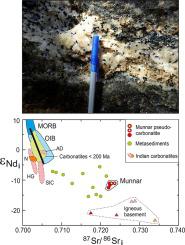当前位置:
X-MOL 学术
›
J. Asian Earth Sci.
›
论文详情
Our official English website, www.x-mol.net, welcomes your
feedback! (Note: you will need to create a separate account there.)
Sediment-derived origin of the putative Munnar carbonatite, South India
Journal of Asian Earth Sciences ( IF 2.7 ) Pub Date : 2020-09-01 , DOI: 10.1016/j.jseaes.2020.104432 Ernst Hegner , Selvaraj Rajesh , Matthias Willbold , Dirk Müller , Michael Joachimski , Mandy Hofmann , Ulf Linnemann , Johannes Zieger , Anakkathil Purushothaman Pradeepkumar
Journal of Asian Earth Sciences ( IF 2.7 ) Pub Date : 2020-09-01 , DOI: 10.1016/j.jseaes.2020.104432 Ernst Hegner , Selvaraj Rajesh , Matthias Willbold , Dirk Müller , Michael Joachimski , Mandy Hofmann , Ulf Linnemann , Johannes Zieger , Anakkathil Purushothaman Pradeepkumar

|
Abstract Metacarbonate assemblages in high-grade metamorphic terranes often pose challenges when trying to distinguish between mantle-derived carbonatite and sedimentary carbonate protoliths. We present a study of granulite-facies metacarbonate samples of the putative Munnar carbonatite described as decimeter-thick dikes and veins, and layers of a meter-thick metacarbonate and calc-silicate assemblage, respectively. Thin sections of the metacarbonate dike samples show absence of pyrochlore and ubiquitous scapolite, titanite, wollastonite, and detrital zircons are compatible with impure limestone protoliths. Nd and Sr isotope compositions indicate protoliths with Paleoproterozoic crustal residence times which contrast the mantle sources of Indian and global carbonatites. Trace-element patterns display the characteristics of upper crust, and Ce- and Y-anomalies in a number of samples suggest protolith formation under marine conditions. Carbon and oxygen isotope compositions of the metacarbonate samples interlayered with calc-silicate rocks are similar to those in marine limestone. The metacarbonate dikes, however, show mantle-like compositions which are interpreted as reflecting equilibration with mantle-derived CO2 during granulite-facies metamorphism. The dikes yielded a U-Pb zircon crystallization age of 1020 ± 70 Ma and a cross-cutting quartz syenite, thought to be cogenetic, a magmatic age of 620 ± 35 Ma; the hosting gneiss provided a magmatic age of 2452 ± 14 Ma. We conclude that the layered metacarbonate and calc-silicate rocks represent a former marine limestone and marl sequence and the metacarbonate dikes and veins small-volume melts of crust-derived carbonate-rich sediment.
中文翻译:

印度南部推定 Munnar 碳酸岩的沉积物来源
摘要 高品位变质地体中的偏碳酸盐组合在试图区分地幔衍生的碳酸盐岩和沉积碳酸盐原岩时常常构成挑战。我们分别对假定的 Munnar 碳酸岩的麻粒岩相偏碳酸盐样品进行了研究,这些样品被描述为分米厚的脉和脉,以及米厚的偏碳酸盐和钙硅酸盐组合层。偏碳酸盐岩脉样品的薄片显示没有烧绿石和无处不在的方柱石、钛石、硅灰石和碎屑锆石与不纯的石灰岩原岩相容。Nd 和 Sr 同位素组成表明具有古元古代地壳停留时间的原岩与印度和全球碳酸盐岩的地幔来源形成对比。微量元素模式显示上地壳特征,许多样品中的 Ce 和 Y 异常表明在海洋条件下形成了原岩。与钙硅酸盐岩夹层的偏碳酸盐样品的碳和氧同位素组成与海相石灰岩相似。然而,偏碳酸盐岩脉显示出类似地幔的成分,这被解释为反映在麻粒岩相变质过程中与地幔衍生的 CO2 的平衡。这些岩脉产生了 1020 ± 70 Ma 的 U-Pb 锆石结晶年龄和一个横切石英正长岩,被认为是共同成因的,岩浆年龄为 620 ± 35 Ma;承载片麻岩提供的岩浆年龄为 2452±14 Ma。
更新日期:2020-09-01
中文翻译:

印度南部推定 Munnar 碳酸岩的沉积物来源
摘要 高品位变质地体中的偏碳酸盐组合在试图区分地幔衍生的碳酸盐岩和沉积碳酸盐原岩时常常构成挑战。我们分别对假定的 Munnar 碳酸岩的麻粒岩相偏碳酸盐样品进行了研究,这些样品被描述为分米厚的脉和脉,以及米厚的偏碳酸盐和钙硅酸盐组合层。偏碳酸盐岩脉样品的薄片显示没有烧绿石和无处不在的方柱石、钛石、硅灰石和碎屑锆石与不纯的石灰岩原岩相容。Nd 和 Sr 同位素组成表明具有古元古代地壳停留时间的原岩与印度和全球碳酸盐岩的地幔来源形成对比。微量元素模式显示上地壳特征,许多样品中的 Ce 和 Y 异常表明在海洋条件下形成了原岩。与钙硅酸盐岩夹层的偏碳酸盐样品的碳和氧同位素组成与海相石灰岩相似。然而,偏碳酸盐岩脉显示出类似地幔的成分,这被解释为反映在麻粒岩相变质过程中与地幔衍生的 CO2 的平衡。这些岩脉产生了 1020 ± 70 Ma 的 U-Pb 锆石结晶年龄和一个横切石英正长岩,被认为是共同成因的,岩浆年龄为 620 ± 35 Ma;承载片麻岩提供的岩浆年龄为 2452±14 Ma。











































 京公网安备 11010802027423号
京公网安备 11010802027423号